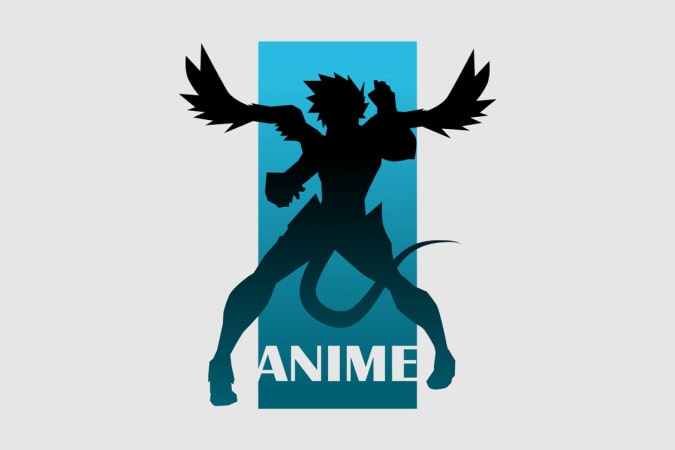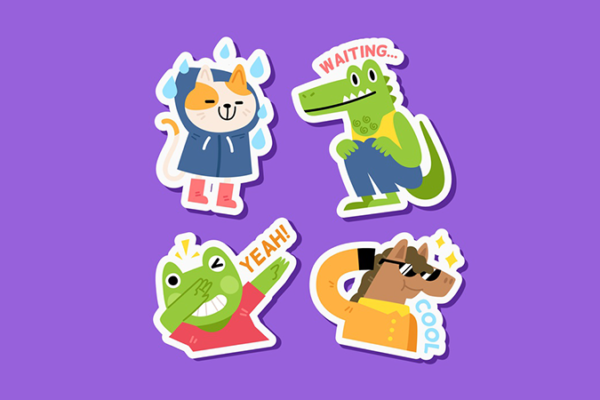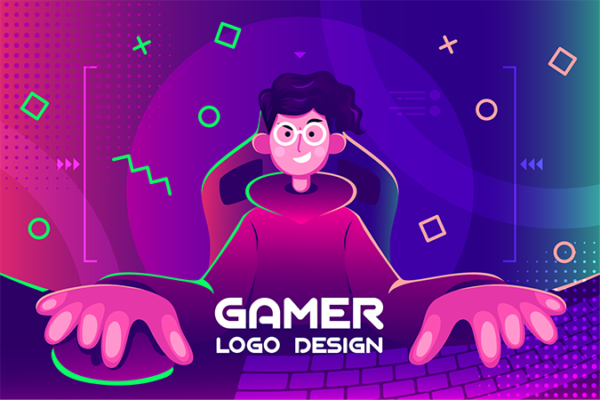
So, you’re here because you want to create an anime logo design? According to a recent assessment by The Association of Japanese Animations, the anime industry made $19.1 billion in revenue in 2017, and it’s still growing! Anime styled logos are very diverse since they appeal to a diverse audience, so finding an anime logo that fits the style of your company won’t be much of a problem! Today, we’re going to talk to you about the best way to make an anime logo design, what its features are, and which aesthetic works best for you.
Table of Contents
What is anime?
The term anime comes from the original word “animation.” In the western world, anime refers to Japanese cartoons. While this style exists since the 1940s, it only gained popularity in the rest of the world in the late 90s.
Want an awesome logo design?
Work with our team to create an anime logo today!
Anime has a big appeal since it creates drama on a spectacular scale. In the Dragon Ball series, just one battle can last for episodes. Other shows like Mushishi or the Tatami Galaxy may seem very calm while there is so much more happening underneath the main storyline. There are coming of age series like Aria the Animation, but also commentaries on cultural imperialism like in Kill la Kill. It doesn’t matter what genre or storyline you’re looking for; it exists. Therefore there is plenty of material to create a logo design for your company! All you have to do is to pick one topic or motif and alter your style to the corresponding anime series, and you’ve got yourself an audience!
A short history of anime design
Before you start working on your trademark, you should know a little bit more about the history behind anime. That way, you’ll have more knowledge to implement in your work. Rather than a long read, we have a visual timeline of the most important works throughout the years for you:
The story of anime starts in the 1940s where Osamu Tezuka found inspiration in Walt Disney. Later, he became known as the Japanese Walt Disney.
1963: Astro Boy T.V. Series
Both Mickey Mouse and Betty Boop influenced the design of Astro Boy. As you may see, his arms and legs had little to no detail. This lack of detail was on purpose as it made the animation of Astro Boy less expensive. There were plenty of features in his hair and belt, though, and his face, eyes, gestures, and body position clearly showed his emotions.
At the end of the 60s, the public got into color television, and slowly, but surely the background became more specific and even started moving a bit. Eventually, Astro Boy’s details were enhanced, and his hair and clothing started moving. These movements created a more significant drama effect.
1969: Dororo
When Dororo came to the market, it marked a new age in which there were animated series for both kids and adults. While the series portrayed both violence and death, te cinematic composition made it into a beautiful presentation for all ages.
1971: Lupin III
With the start of shows like Lupin III, there was a rise in character detail development around the 70s.
1974: Heidi, Girl of the Alps
There was not much action and violence in Heidi. However, the drama came to the front through the detailed expressions of the characters. This series was also a show in which the backgrounds were incredibly accurate.
1979: Mobile Suit Gundam
While this show only started at the end of the 70s, it marked a new hype, which increased anime’s popularity: mechanical war-fighting suits (mech). Animators had a hard time animating sophisticated machinery, but Mobile Suit Gundam brought a change in that.
1982: Macross
Before the start of Macross, backgrounds didn’t match the foregrounds as much. When Macross aired, they created an indistinguishable background animation that started a leap in animation methods.
1984: Angel’s Egg
Animators began to look for other ways to create anime and went for an expressionistic look. This look was a blend of dream realms and reality. Angel’s Egg started this look.
1986: Gundam Z.Z.
In 1986, animation’s linework and shading details evolved after airing Gundam Z.Z.
1986: Castle in the Sky
While it’s still an anime, Studio Ghibli raised the bar in realism. The characters move smoothly, just like their artistic backgrounds. The characters weren’t real, but their colors and movement made them feel real. For the background, Studio Ghibli employed more animators than ever before.
1987: Bubblegum Crisis
This series was the start of the Japanese Cyberpunk Future style by creating cityscapes and using neon colors.
1988: Akira
Akira is famous for being the most technically advanced anime from the 80s. It also reached a broader audience than all the series before had done. In the end, this series had much impact on the future of anime.
1995: Ghost in the Shell
Anime with a realistic twist. Ghost in the Shell used both correct body proportions and photorealistic backgrounds. What many people may not know is that the Matrix used many elements from this anime in their debut.
1998: Cowboy Bebop
Cowboy Bebop gave expressionism a new look in the 90s. The series is a combination of different anime styles.
1998: Serial Experiments Lain
In the 2000s, people started experimenting with visuals. Visuals represent the subtle daily oddities we experience daily. Serial Experiments Lain used muted color palettes and started with visuals just before the start of a new era.
2000: FLCL
FLCL combines colors, composition, and technical mastery while using the expressionistic approach from the 70s.
2006: Ergo Proxy
If you’ve already seen Serial Experiments Lain, you’ve probably noticed that Ergo Proxy uses the muted color palettes and dream-like fighting, but with a darker twist.
2017: Lu Over the Wall
Lu Over the Wall brings us back to the 40s with the lack of detail and cute characters. However, this color palette is incredibly vivid.
How to make your cool anime logo design
Our next step is to give you a detailed walk-through on how to use the anime style in your cartoon logo design. We’ll also look at how the following logo examples represent their brand. Your business doesn’t need to have anything to do with cartoons. An anime look creates enough magic for it to succeed.
Typography and lettering
You can usually recognize whether a show is an anime or not by looking at the typography. The elements target specific age groups, ranging from smaller children to adults. The fonts and typefaces look similar to traditional Japanese writing, or like machines. The way these letters look to represent the style and tone of the series.
Most series write their titles in English but use a style that makes it seem Japanese as well. The rounded corners bring expressionism to our realistic little world.
If you want to get your name out there, anime lettering is the way to go! If your brand’s initials look well together geometrically, or if you have an appealing repetition, you may do well using a monogram logo. You should also consider this when your logo is too long to look good in a small design.
Even if your brand identity has nothing to do with anime, the lettering may still look good. Since there are so many topics and genres, you are bound to run into a crossover. Take a look at the vast amount of mecha anime. Those typefaces do incredibly well with tech companies.
Icons and logos
Animes often have at least one logomark. This logomark can be an object, image, or abstract symbol worn by one or more characters in the series. Logomarks are hugely popular since fans can use these marks to wear, paint, print, tattoo, and more to show their support.
Since many logomarks are purely geometric, they can represent a trait or ethos. When you use such a mark, it implements itself into the emotional part of your audience’s brain and will help your brand recall.
Take a look at the Poké Ball. This small Pokemon catching device gets recognized all over the world. Even the youngest or eldest people often understand this icon within an instant.
If you want your customers to wear your symbol, the anime logo design style is for you! Japanese culture honors symbols as they are tradition. According to lore, they possess power. Can you imagine your whole brand’s personality into one single mark?
Anime uses icons that fit their specific world, like Pokemon, Dragonball, and Cowboy Bebop. You can’t transfer it across other universes.
While this may seem like a recipe for exclusion, it helps to amp up the curiosity of your audience. The audience wants to know more about it. When you advertise yourself probably, you can even earn a great loyal customer base.
Characters and Mascots
Every series has at least one (main) character that becomes their mascot logo. Fans see this character and will instantly think of the series and the message it holds. It’s their hero, their villain, or someone they relate to. All these things are emotional.
Anime mascots have a recognizable signature: wild hairstyles, pumped muscles, and cute uniforms. Cosplayers and Japanese pro-wrestlers alike get their inspiration from these various characters. Just like biomechanical items are a staple in the world of cyberpunk. The character’s body language inspires confidence and conviction to do what’s right. Anime also uses a broad range of expressions, allowing us to see so-called puppy eyes, nervousness, hunger, and contentment.
When your company has a charismatic spokesperson or character that represents your ethos, you may benefit from a mascot logo design. Who will recruit new customers, who are the champion of your business? Make it into an anime version, and you have your personalized mascot!
Your company doesn’t need to be Japanese to benefit from using an anime mascot. The youthfulness and modern elements are appealing to anime-loving and regular audiences alike. Just as we saw with Ghost in the Shell, non-anime brands like the Matrix can hint at anime aspects in the way they represent their characters or settings. That way, you combine anime elements with other cartoon elements to create a design that sticks with your brand.
Use anime’s popularity to your advantage
Anime is everywhere. In the past four years, Netflix sales, Chinese Streamers, and Amazon tripled overseas sales! Tings like Comic-Con, Cosplay, make-up tutorials, children’s cartoons have all surged tremendously and continue to grow. Anime is big and powerful. Use the knowledge we gave you to create your anime logo design and watch your company rise!



